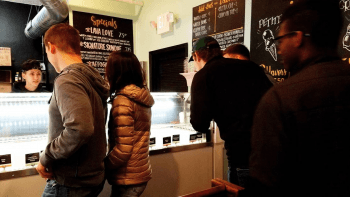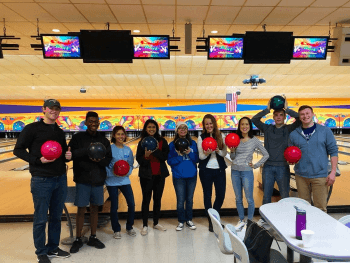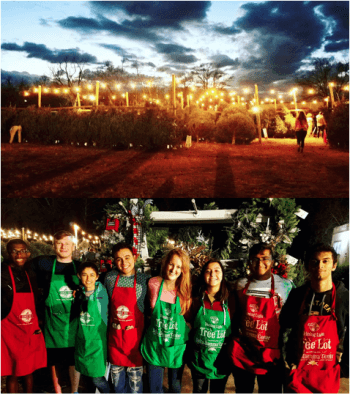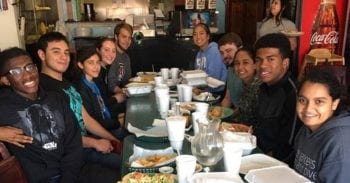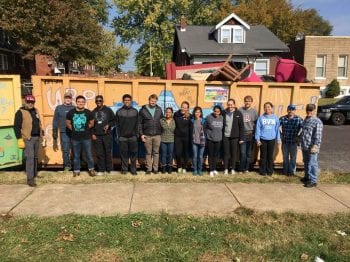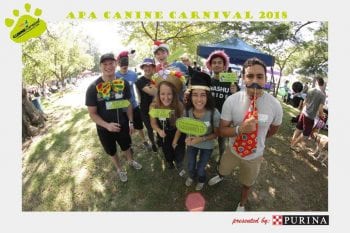Stay updated with our team and follow us as we prepare for our projects!
8/13/19 – Seeing an Irrigation Site
We left St. Francis first thing in the morning with the Omoana team. Five hours later, we finally reached the Bongole farm. We started with introductions and the traditional signing of the visitor book on the front porch. Then farmer John started walking us around his 40 acre farm, explaining his extensive irrigation system as he went. We stopped by a couple shallow boreholes, storage tanks, a resivoir, community water source, and many hose outlets. Along our way, we saw his piping system, complete with valves and connectors.
John described how the whole system works together powered by petrol pumps in several locations and flowing through flexible piping to surface and buried drip emitters, sprinklers, and taps for hand watering. We learned a lot about the logistics of irrigation and it was very helpful to see an example.
Since we were already so far south, we drove an extra 20 minutes to the equator line. It was Rachel and Marie’s first time stepping foot in the Southern Hemisphere!
Then we began the long journey back to Jinja. By the time we arrived at St. Francis, it was around 9:30pm. We were so sad that it was our last night in beautiful Uganda. We finished our trip with a closing meeting with the Omoana team, then said our goodbyes and headed back to the hotel to pack before the journey home.

Our group straddling the equator

Showing off our walking sticks after the tour of Bongole farm
8/12/19 – Spending TIme at Bulubandi
We started the day by visiting a school in Kikondo to learn from their solar-powered water system with the Omoana team. They explained to us the details of their pump, solar panels, storage tanks, and automated control system. Lisa and Marie even climbed to the top of their water tower to see the storage tanks and how the system filled each one. This tour gave us a great example and helped us visualize our project’s future.
Then we set out to Bulubandi Primary School in Iganga. This is where our sister WashU team is working to put in a clean water source. We picked up lovely Sumaya on our way out of Jinja. Within the hour, we arrived at Bulubandi where Rebecca, the head teacher, warmly welcomed us. The afternoon was spent taking a tour of the school and gaining better understanding of their needs. The students were on their lunch break during the tour, so we got to see them filling up their cups from the tippy taps and playing all around.
Our tour concluded and we were able to collect water samples from the well of a nearby mosque to be tested. Then, there was a classroom meeting with staff members and students to discuss water usage and hygiene habits.
Our visit ended in playing with kids around the school and eating fresh strawberry bananas that were given to us by the school staff. Rain started falling as we drove away.
Before we left Iganga, we enjoyed dinner at Sol View cafe, a staple from the Bulubandi team’s trip in May. After dinner, we stopped in at UDHA, the NGO associated with Bulubandi Primary School project, where we met with Moses, the executive director.
We wrapped up the day with a pit stop for snacks and water on our way back to Jinja.
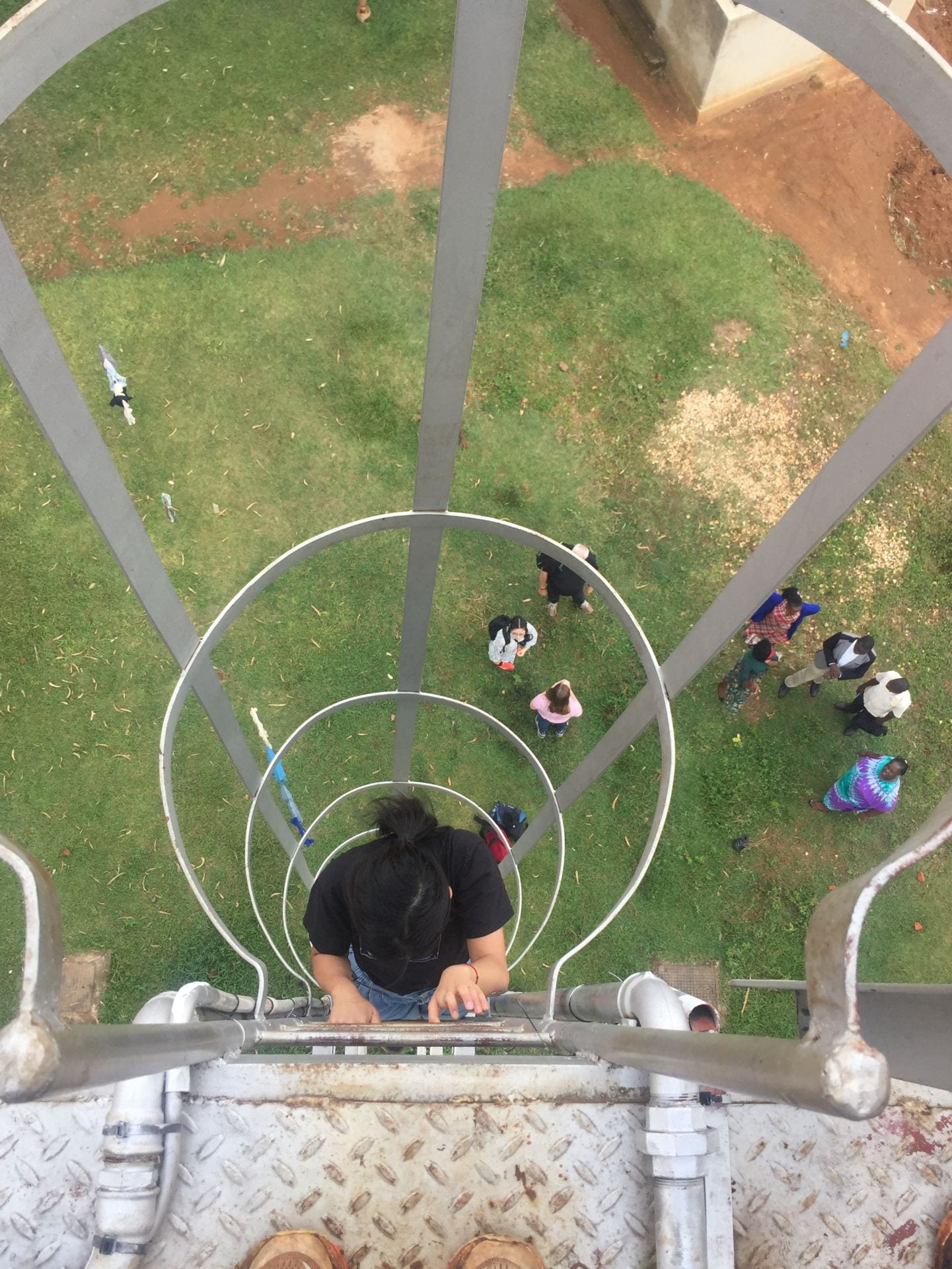
Lisa climbing up the water tower

A Bulubandi Student filling up their cup at lunch time from the tap
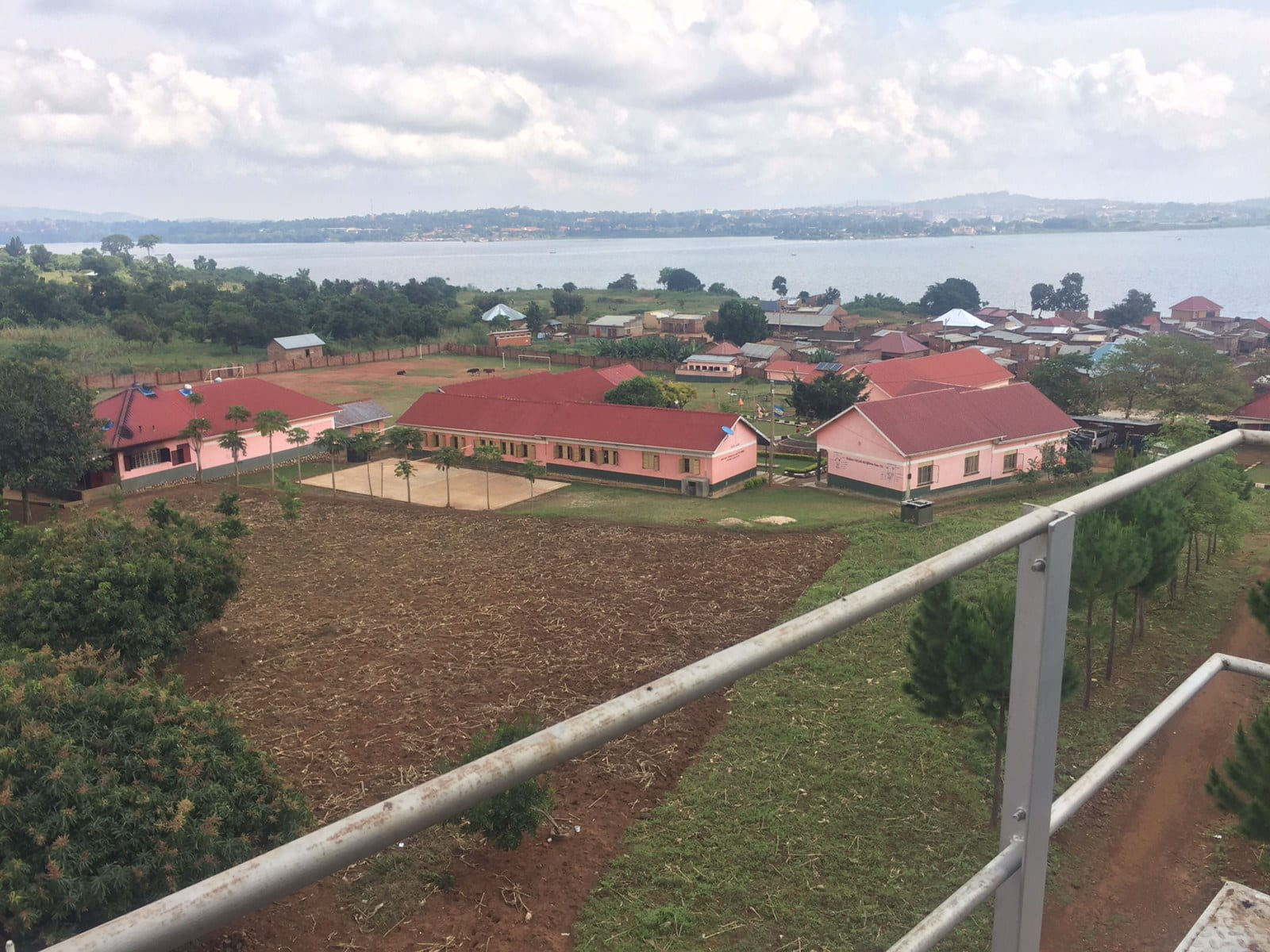
Looking out from the top of the water tower
8/11/19 – Sunday Survey
This morning we went back out to the field with Tarasi and a hydrogeologic surveyor. The purpose of the hydrogeologic survey is to determine if there is water underground that could be accessed by a well. While the surveyor worked, our team continued our efforts to map the farm land to scale, including where and how much of each crop is grown. We also talked to Tarasi about crop production and food usage at the Omoana House. We tried fresh passion fruit and bananas grown on the field!
Then, we went back to the Omoana House to draw a dimensioned diagram of the cook stove and the kitchen building. We discovered that the exhaust pipe for the cook stove isn’t ventilating, which is causing their problems with interior smoke.
To end the day, we took a boat ride to the source of the Nile, floating from Lake Victoria into the Nile River. We also got to see many different birds and a few lizards! We finished the day with a good dinner at Java House.

Solving the map mystery

Boat ride to the source of the Nile

WashU crew at the farm
8/10/19 – Saturday in Jinja
We woke up this morning (as we have each morning here) to local birds chirping. Within the hour, it was raining, as Ray says, lions and hippos. After breakfast at the hotel of eggs, sausage, and bananas, we hauled through the rain to the Omoana house. There, we got to join the kids and staff for a short video about the Omoana house made by a team from Kampala and the beginnings of lion king. Lisa got to show off her engineering skills by helping out with technical difficulties.
Once the rain had slowed to a drizzle, Tarasi and Teddy guided our shopping trip into Jinja town. Then, with full shopping bags and lighter wallets, we made our way to an Indian restaurant for late lunch.
We spent the rest of the evening at the hotel enjoying music from a wedding down the street and our now fragrant water tests.

We watched a video about the mission of the Omoana House with the Youth Positives club, a group of children rehabilitated by the Omoana House that returns every Saturday for health education and fun activities

We shopped for souvenirs at a market in Jinja Town
8/9/19
Today has been physically draining and mentally enlightening. We started the day at St Francis where we used duct tape to attach our air particle tester on the wall of the Omoana house kitchen.
Then we set out with the Omoana team (Tarasi , sister Ruth, Teddy) to the Njeru Municipality office (Local Council 4) where we met with the district water engineer, health inspector, and senior environmental officer. The meeting was a whirlwind of questions and discussion about a hydrogeological survey, environmental impact report, and community engagement.
From the office, we drove out to the field site to meet our land surveyor and collect data. Lisa, Ray, and Marie worked on soil percolation testing, which involved digging holes, fashioning makeshift measuring sticks from sugarcane stalks, and filling our jerry can from the stream at the bottom of the property. Rachel and Soo Jin spent their time measuring and testing the properties of the stream. Finally we joined up to sketch a map of the different crops with or trusty measuring tape. We also got to sample fresh mango, hibiscus leaf, maize, and ground nuts (peanuts)!
Sweaty, dirty, and exhausted, we piled back in the van. Once we got back to St. Francis, we took down our air particle tester that had been running all day, acquiring data and additional duct tape. After a quick planning pow wow with Alli, our team stopped for a satisfying dinner on our way back to the hotel.

Measuring a plot of sweet potatoes
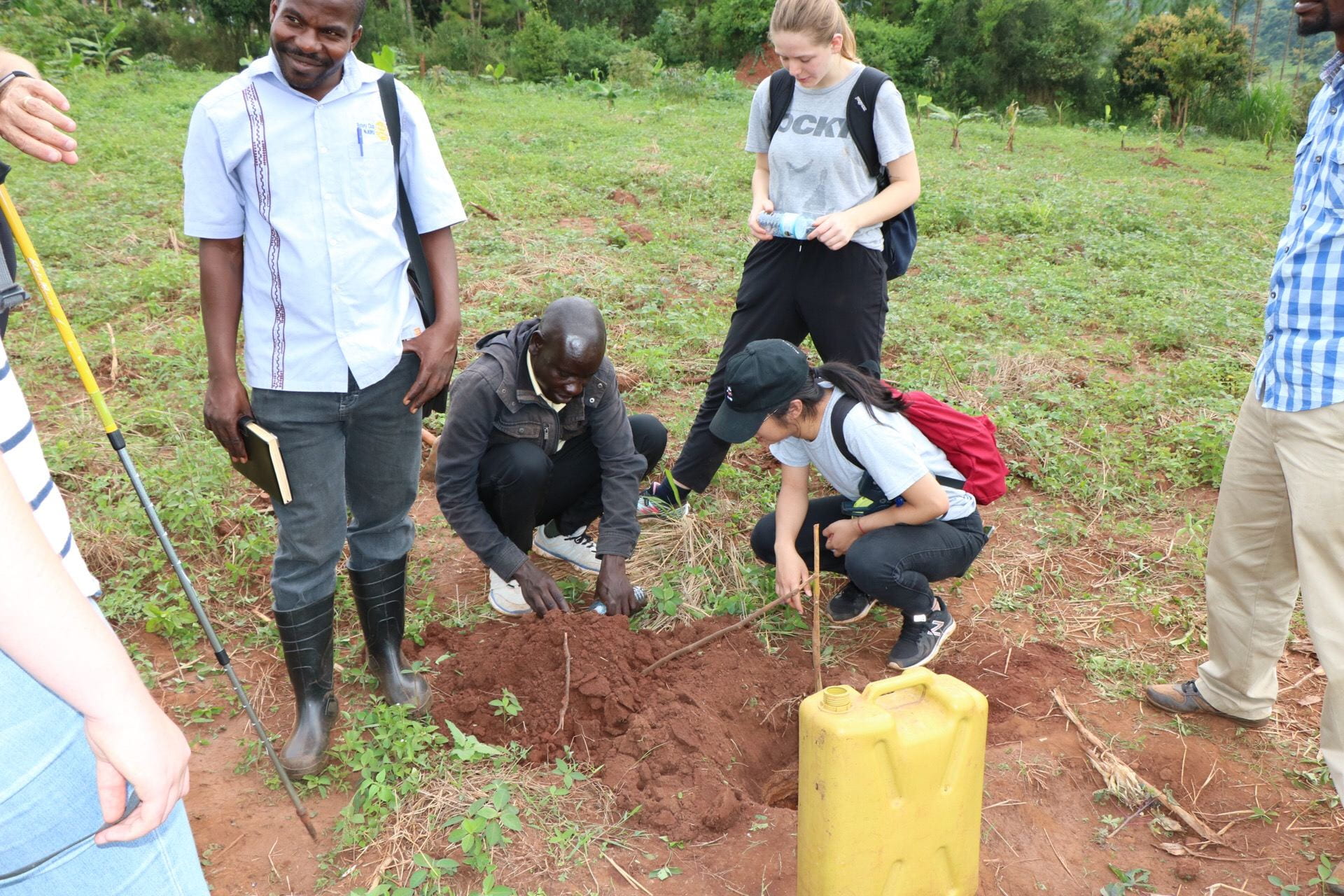
Collecting a soil sample near our hole

Rachel eating a fresh picked mango
8/8/19 – Excursion into the community
We met with the local council, community leaders and representatives together with the Omoana team over a beautiful view this morning. We had a constructive discussion with the community members with our plans and exchanged our expectations for our irrigation project. In the end, we were able to get a much clearer picture of the current situation of the community and their needs. After the meeting, we were able to take an excursion down the hill to see and take water samples for testing from a 20 year old protected spring which the community members are currently fetching water from.
With the help from Alli, we were able to get a hotspot for our air particle sensor so that the internet connection will allow us to collect real time air quality data anywhere in the world. Then after a lovely lunch of traditional Ugandan food, we went back to the Omoana house to set up the air particle sensor in the kitchen for a test run. The configuration and installation went smoothly and we were able to see the collected data on our phones, which was a very exciting moment of our day!
After we went back to our hotel, our team got together to test our the water samples we obtained from the spring, and we are still anxiously waiting for the E.coli presence test to incubate in a couple of days.

Installing air particle sensor in the kitchen

Collecting water sample

On our way to see the protected spring

Meeting with local community leaders
8/7/2019 – St. Francis Team Arrives to Uganda
Hello from Jinja!
Our journey to Uganda started in Washington DC for some of the team and Hong Kong for others. We all met in Dubai to continue on to Entebbe. After our 20 hour journey by flight, we drove from Entebbe to Jinja. Despite a flat tire in the jungle, we made it to our hotel and slept soundly after a long day!
Today, we saw our fabulous community partners, the Omoana House and St. Francis Healthcare Services. We met with the executive director of St. Francis, Faustine Ngarambe, and the director of volunteer services, Ali Nyende. They explained to us all the great work that the health center provides including rehabilitating HIV/AIDS positive kids, providing prenatal care for expecting mothers, administering immunizations, and more. Next, Ali gave us a tour of the facilities, showing us their lab, maternity ward, and children’s ward.
Afterwards, we traveled to Kampala to see the Engineers Without Borders Kampala Office. We met with Habert Ongom and Lydia Kyokaali who assisted with our plans for testing and surveying the land that will be used for irrigation. Their advice was very helpful for assessing the water to be used for irrigation.
After driving back to Jinja, we enjoyed dinner at Java House before heading back to our hotel. Overall, a great first day!
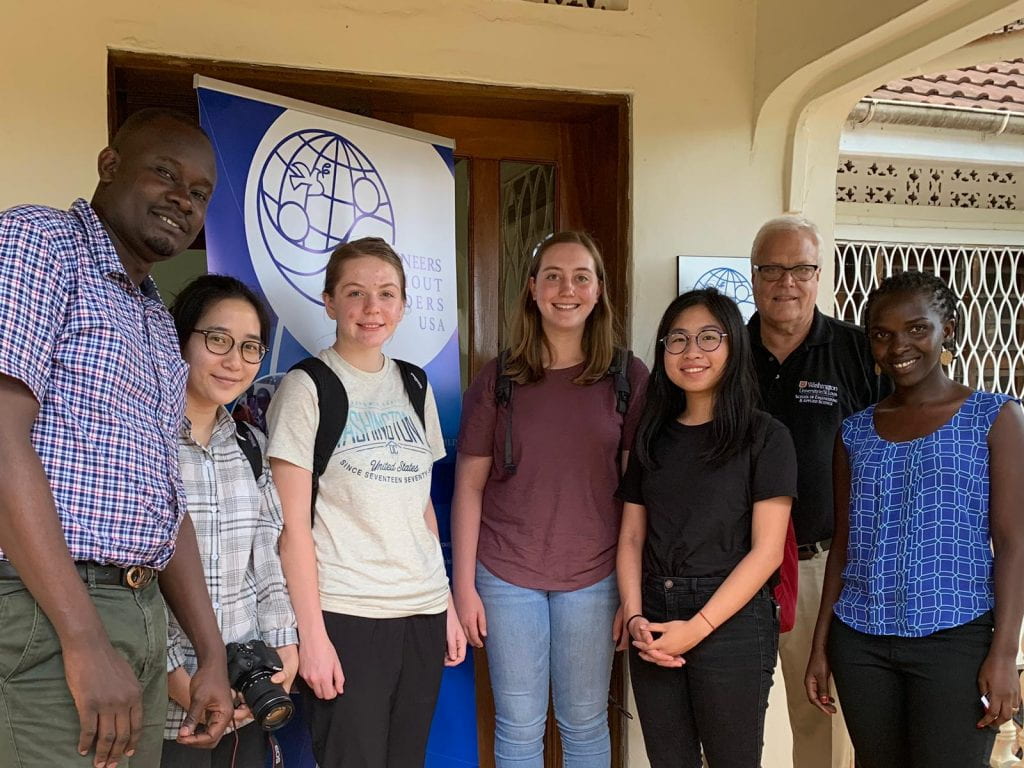
Meeting with the EWB Kampala team
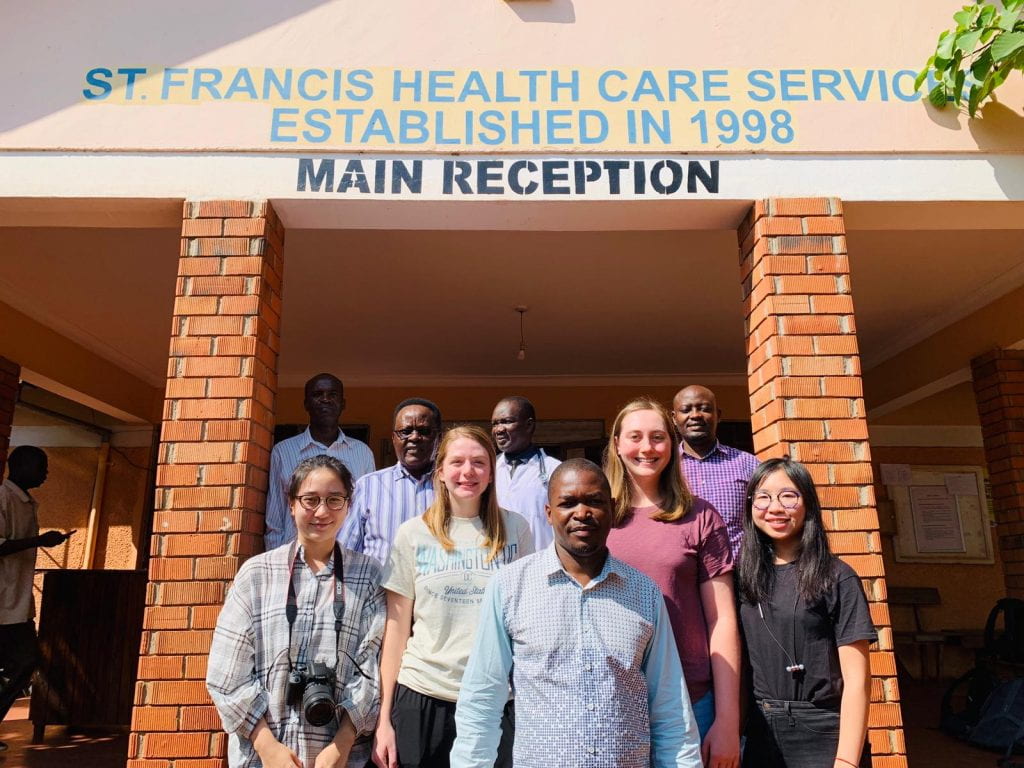
Meeting with the St. Francis Healthcare leadership
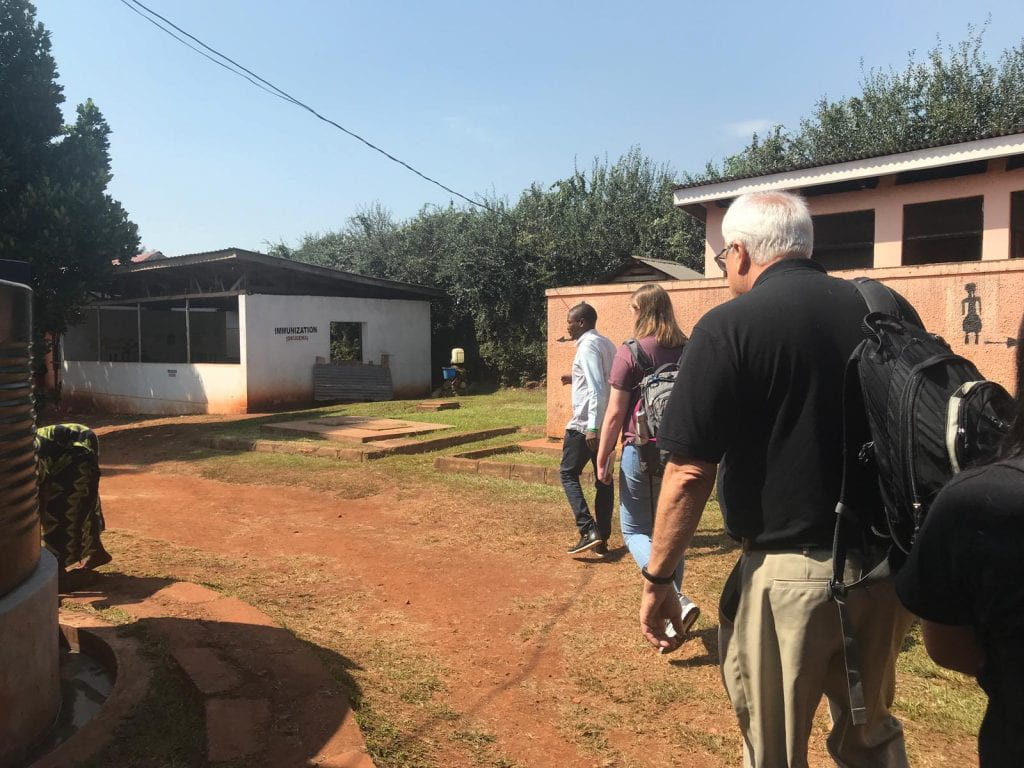
Touring St. Francis Healthcare and the Omoana House
5/28/19 – A Hard Goodbye
On one of our final days in Iganga, Ruth invited us to her home to meet her children, two of whom are biological and the rest of whom she has taken into her family over the years. They taught us some of their favorite games, and we played them in the yard outside. These games included some tagging, some picking up sticks, dodging balls, and moving of the hips. Afterwards, the team came inside for a sing and dance performance, which soon turned into a dance lesson. Many thanks again to Ruth and her children for welcoming us into their home and making us feel like part of the family!
On our last evening, we ate dinner with Ruth, Gideon, Rebecca, and Sumaya — the four wonderful Ugandan superstars who have been the guiding lights of our trip. We exchanged old stories and words of gratitude over a meal. Early the next morning we all met up again for a final sendoff. After growing so close the these four mentors over the past week, it was a hard goodbye to say the least. We piled into the van around 6 am and began our long journey home. We drove to Entebbe, stopping briefly at the nearby mall to rest before hitting the airport. We boarded the plane at 3 and flew five and a half hours to Dubai. We spent four hours at the Dubai airport, marveling at the complete change of pace and culture that this airport presented. Late into the evening, we boarded our 13.5 hour flight to Washington, D.C. We landed at 8 am, delirious but glad to be back. We hugged one last time before splitting off and going our separate ways for the rest of the summer.
Thanks for tuning in and following along with our journey!

We joined in a few games with Ruth’s kids in their backyard.

The final dinner!!
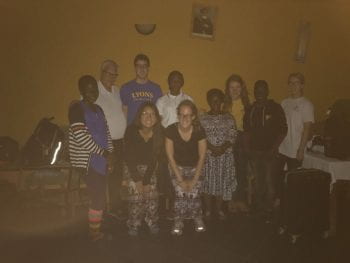
Tired faces and a sad goodbyes as we left the hotel at 6 AM the morning of our departure.
5/27/19 – A Peek into "the Lab"
Another key part of this trip was to collect quantitative data about the Bulubandi School’s property and surrounding conditions. This included collecting and testing water samples from the school’s current water source (an unreliable tap supplying the national water), a nearby protected spring, a couple nearby wells, and a sample from the stream at the St. Francis agricultural property. Ben and Mae used a water testing kit to test each sample for its iron content, arsenic content, hydrogen sulfide, nitrites and nitrates, manganese, pH, and bacteria presence. An incubator was necessary in order to conduct the bacteria presence/absence test. In order to make an incubator, Mae and Ben covered a cardboard box in tinfoil, propped open the lid, and placed a carefully wired lightbulb by the opening of the lid to heat its contents to the desired 35-37 degrees celsius. They placed the sample pouches in the box and let them incubate for 36 hours. Samples that remained yellow in color had bacteria absence, while samples that turned blue/green had bacteria presence. When a blacklight was shone on the samples, all samples that glowed in the light were shown to have at least trace amounts of E Coli.
If we decide to implement a hand washing station and menstrual hygiene wash station at the school, we will need dispose of gray water using a soak pit or drain field of some kind. We conducted a percolation test of the soil to determine the water absorption rate of the soil and thus the necessary size of the drainage field. To do this, we dug a hole of a diameter of approximately 6 inches and depth of approximately 12 inches. We saturated the soil by filling it with water, letting this water soak through, then refilling the hole and measuring the depth the water level changed over time.
Finally, we used string, eye levels, and a measuring tape to determine the elevation change of particular sections of the property. If an underground piped water distribution system is to be put into place, elevation changes will help determine how much of this piping can be powered by gravity and how much will require a pumping force.
We hired a hydrogeologist to come conduct a hydrogeological survey on the school property. This included using electromagnetic sensing machinery to detect the elevation of the water table throughout the property, and using this data and geological composition to conclude the best place and depth to drill a borehole.
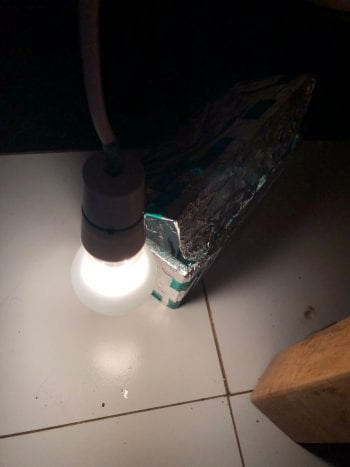
An up-close of the makeshift incubator, in which the bacteria test samples were placed.

The bacteria test samples after they had been incubated. Samples that appear yellow had an absence of bacteria, while those that appeared blue/green had presence of bacteria.
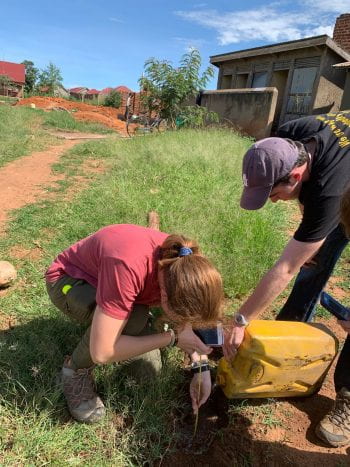
Mae and Ben fill one of the holes with water for the percolation test.
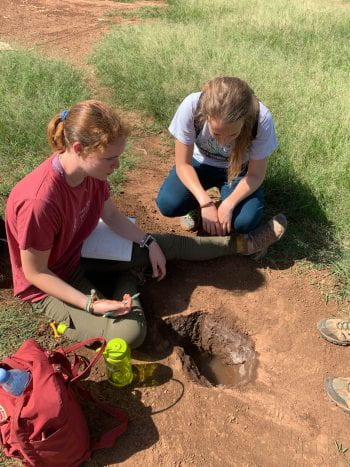
Mae and Sarah stand by as the water soaks into one of the pits for the percolation test.

Emily and Sarah work on measurements of the school property.
5/26/19 – Visits to Nearby Projects
Over the course of the trip, one of our main information gathering methods was through visits with related local projects. One such project was a solar panel powered project in Bucia. Sarah, Ben, and Ray made the trek out to Bucia, a town near Uganda’s eastern border with Kenya. This project featured a large solar-powered pump atop a community production well. A production well is a deep borehole well (generally over 45 meters deep) that is pumped using electricity into a nearby tank, which stores the water. Water is piped from the storage tank to taps, at which community members can fill jerry cans and use the water.
On another day, Louise, Sarah, and Emily drove out to the nearby community of Nambale to see a community water distribution system. Members of the Bulubandi Primary School’s Management Committee expressed interest in having water tapped out to different areas of the school and potentially even out to the surrounding community. The girls observed the Nambale project’s elaborate tap kiosk, in which community members paid per jerry can of water.
Finally, we all checked out a water project done through Water Mission in the outskirts of Iganga. This system involved a solar-powered pump on a production well. The water was pumped out of the well and to a purifying station, at which the water was chlorinated before entering the main water storage tanks. The water was then pumped out to various taps within the community. The community’s unique chlorination feature gave us a different perspective on potential water treatment options.

The main water distribution access point at Bucia

Ben, Ray, and Sarah meet with the leads at the Bucia site.
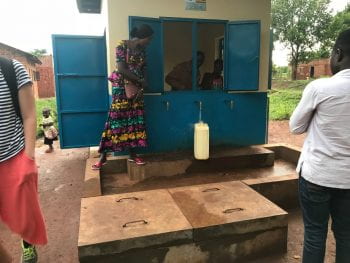
Rebecca, Bulubandi Primary School headteacher, checks out the tap kiosk system at Nambale
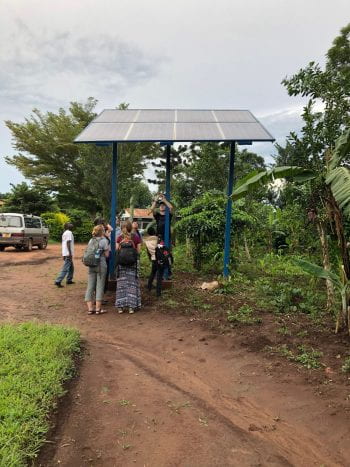
The Bulubandi team peers at the solar panel setup that pumps water from the Water Mission production well
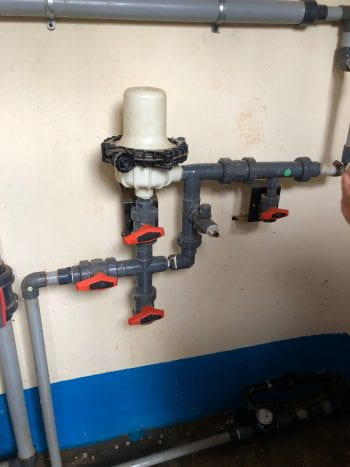
A closeup of the chlorination feature at the Water Mission system. A small (and adjustable) fraction of the water is diverted from the main pipe into a chlorinating pipe, and from there all the water is mixed in the main water storage tanks.
5/24/19 – A Visit to St. Francis
During our stay in Uganda, we drove out to the rural outskirts of Jinja to take a look at the site for our fellow WashU EWB team’s current project. The St. Francis project team will be heading out to Uganda this August, so we got a glimpse of the site and met the Ugandan partners to provide the St. Francis team with some preliminary information. The St. Francis project is partnered with the Omoana House (“omoana” translates to “baby” in the local language of Lusoga), a facility in which children of HIV/AIDS are rehabilitated and reintegrated into their communities. Omoana House is sustained by a 10 acre plot of crops several kilometers from the building, in a remote rural village. At this plot, corn, sweet potatoes, cassava, and other crops are grown to provide the house with food and funds. The EWB St. Francis team will be working with the workers at Omoana House to create an irrigation system for this plot, a consistent water system for the plot’s surrounding community, and a better ventilated cookstove system for the house’s kitchen. We got a tour of Omoana House and the other facilities at the location, as well as a bumpy ride and hike out to the farming plot. Shoes got muddy, backs got sweaty, but hearts were full as we goggled at the lush, raw landscape of St. Francis.
On the way to the site, we stopped at an art market in Jinja to scout out some keepsakes from the trip. Some were better at bartering than others, but we all came out with a healthy crop of souvenirs.
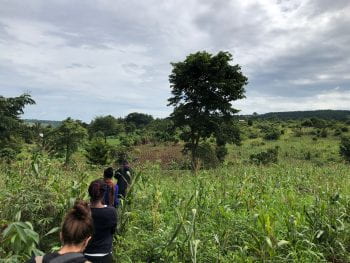
The view as we walked through the agricultural plots of the St. Francis project

A glimpse of Omoana House as Alli gave us a tour of the facilities
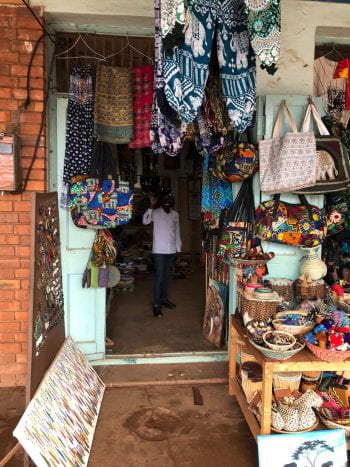
Gideon waves hello from inside a shop at the art market in Jinja
5/23/19 – An Innovative Incubator
We started off today early and headed to meet the head water engineer at the water office. He hooked us up with a trusted local hydrogeologist, with whom we soon set up a time to meet and implement the survey on Bulubandi grounds. He gave us excellent insight on pump specifications and approximate pricing.
Excited about what we’d learned, we headed to the school. There, we began to chart out measurements of the school grounds and met with members of the school management committee to make decisions and form a water committee. Rebecca and Ruth were incredibly helpful in translating between Lusoga (the most common language of the area) and English to ease communication. We made promising strides in constructing a plan for future well maintenance and funding. Exciting!
At the end of the meeting, we split the community leaders into two groups for a participatory activity. Each group worked together to map out major roads, footpaths, water sources, resource centers, and other major landmarks in the community. Ben and Ray then collected water samples from a couple nearby wells and springs, as well as the city water from the school’s tap. The team headed to Victoria Cafe again for lunch and chowed down on some more Ugandan classics.
Following lunch, Sarah, Emily, and Louise headed back to the school to finalize measurements of the school plot and collect soil samples for testing. Ben and Mae stayed behind at the hotel to use a light bulb, cardboard box and some tinfoil to rig a makeshift incubator and start testing the water samples.
The team reunited for dinner at the hotel — including some African tea (boiled milk with ginger, tea masala, and other miscellaneous spices). They each popped a malaria pill and headed off to bed.
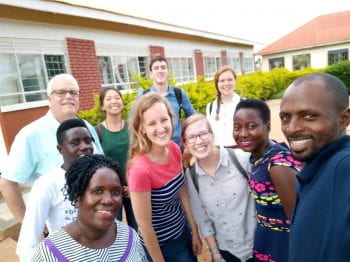
A picture of the entire team, including Paddy from the EWB office in Kampala. From left to right: (back row: Ray, Louise, Ben, Mae) (frontish: Gideon, Ruth, Sarah, Emily, Sumaya, Paddy)

Ray signing the visitor book in the administrative offices at the school. On the left is Rebecca, the headmistress at the Bulubandi Primary School.
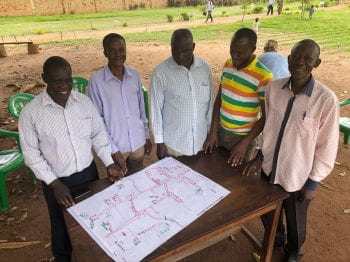
Men’s resource map during the participatory activity designed by Dr. Shanti Parikh at WashU in coordination with Ruth.
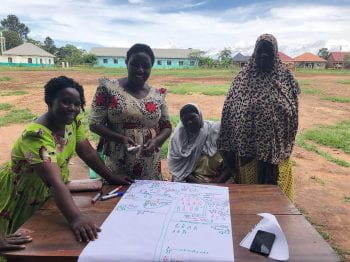
Women’s resource map during the same participatory activity.
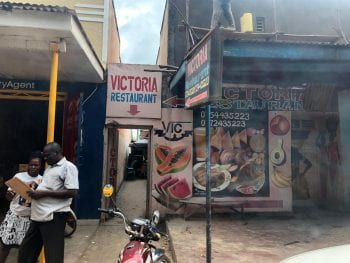
Victoria cafe where the team has eaten lunch the last three days. Today, Gideon and Ruth joined us and we ate fish and beans— team favorites!
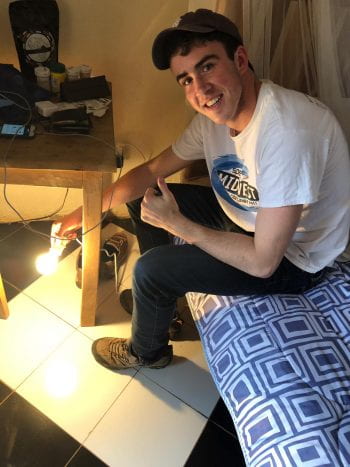
Ben with the beginnings of the bacterial incubator. The incubator is used for tests examining levels of total coliform and E. coli in the water from various sources.
5/22/19 – Meetings in Iganga
Today Ruth led us around on a grand tour of the community leaders of Iganga. Patty, the Program Coordinater of the Ugandan EWB Office, joined us on our tour. She introduced us to the regional police chief, the chief of the chiefdom in which we are working, the assistant water engineer, the deputy regional district chair, the chief administrative officer, the district education administrator, and the natural resources officer. Each gave us unique insight into cultural history of Iganga as well as local water and well records.
They gave us their blessing and full support and wished us well on our way (but not after taking a picture of us and having us sign their visitors book of course!!). We stopped to get Ugandan food at a cafe for lunch. We tried some beef and chicken, as well as a plate of miscellaneous starches, including sweet potato (Iganga’s specialty!), matooke (doughy plaintain cooked in banana leaf), posho (made from maize flour), cassava root, collard greens, and gnut (peanut) sauce.
We stopped back at Bulubandi School to check in with some people and further familiarize ourselves with the school property. We headed back to a cafe to try to glean some wifi (well…”wifi”), fill out paperwork from Patty, and and plan out details for the next couple days. We ate rolex (chiabatti, eggs, and vegetables all rolled up) and tried passion fruit juice while bouncing ideas back and forth.
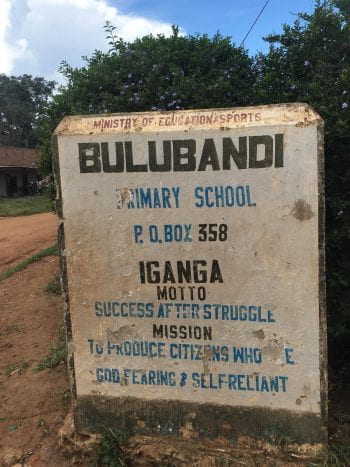
Sign for the Bulubandi Primary School.

Lunch at Victoria Cafe.
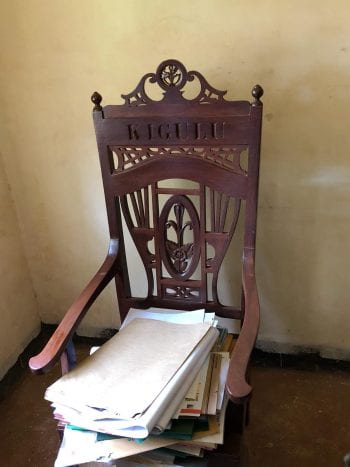

Education office.
5/22/19 – Greetings from Iganga!
The past 48 hours have been quite the whirlwind. After meeting in DC the evening of the 18th, we set off on a 20 hour journey to Entebbe International airport via Dubai the next morning. We got lucky at our Dubai transfer and just barely skidded onto our flight to Entebbe, literally spending minutes in the Dubai airport before boarding our final flight. Unfortunately, our bags didn’t have the same luck; they spent the night in Dubai.
We were greeted outside the airport by lovely Sumaya, a representative of UDHA (Uganda Health and Development Associates) who has proved to be instrumental in the trip so far. We piled into the van and started the drive to Iganga. After stopping at a mall to stock up on Ugandan Shillings, a couple cell phones, and some groceries, we spent the next seven hours taking in the bustling market stands and slipping in and out of consciousness from the backseat of the van. At long last, we reached Fort Lugard Hotel! We slept well that night.
The next morning (5/21/19) we had a brief meal at the hotel with Sumaya, Ruth, and Gideon before stopping by Bulubandi Primary School, where we’ll be implementing our project in the next few years. Rebecca, the Deputy Headteacher of the school, gave us an overview of the school and introduced us to some of the students studying there.
Emily, Louise, and Ray headed back in the van with Sumaya to visit the national EWB office in Kampala and retrieve our luggage from the airport. They spent quite a few more hours in the car, returning at around 9:30 pm, but it made it worth it to know that we’d be taking cold showers (but with soap!) that night and be able to change into clean clothes.
Ben, Sarah, and Mae stayed at the school for several more hours. Rebecca gave them a tour of the school’s facilities, explained how the schooling system is set up, and patiently answered a slough of questions from the team. The three then went into town with Ruth to grab lunch, explore the local markets, and walk back to the hotel to rest up and plan out the next few days. The team reunited for dinner and updates out at a cafe in town.
It’s good to have clean clothes.

Meet Sumaya!
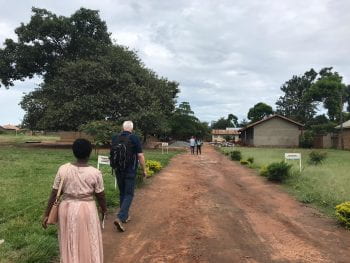
Walking at Bulubandi Primary School, where our projects will be implemented.
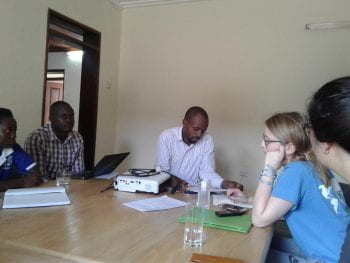
Meeting at the EWB Office.

We were finally reunited with our bags!
2/16/19 – Dinner with Hope Lodge
On Saturday, the Local Project worked with the American Cancer Society at a Hope Lodge, which provides free housing for cancer patients. Part of the reason that this is successful is due to the help from the community. To do our part, we served dinner to all of the residents and caregivers at Hope Lodge.
2/2/19 Ice Cream for Breakfast!!
2/2/19 – Bowling with St. Louis Arc
12/1/18 – Shining Light Tree Lot
On Saturday, we helped out with the Delta Gamma Center’s annual Shining Light Tree Lot. The proceeds go to help children with visual impairments through family-centered support and specialized services. We spent the evening selling and helping people pick out trees for the holidays, securing trees to people’s cars, and keeping the lot fully stocked and organized. Thanks to everyone who came out to volunteer!
10/27/18 – Tacos with the Team!!!
10/27/18 – Gravois Park Clean Up
This past Saturday, we spent the morning working alongside Brightside St. Louis to help clean up Gravois Park Neighborhood! We went to five different alleys that neighbors had requested aid with, removing abandoned furniture and cleaning up trash and recyclables. We lucked out with clear skies and beautiful weather.
9/30/18 – Canine Carnival & Fast and Furriest 5k
On Sunday Morning we volunteered with the Animal Protective Association’s Canine Carnival & 5k in Tilles Park. We directed traffic and cheered on 5k participants (both two- and four-legged) along the route, and after our shift had the chance to explore the carnival. The event looked like a huge success and had thousands of attendants, raising money to help animals around St. Louis find homes and obtain needed medical care.
9/29/18 – Light the Night Walk
On Saturday we walked over to Forest Park to help out with the Leukemia & Lymphoma Society’s annual Light the Night walk. The event brought thousands of people from all over St. Louis and raised over $852,000. We got set up fielding questions from guests and directing people to the event, and got to talk to a lot of folks in an amazing and humbling network of people.
